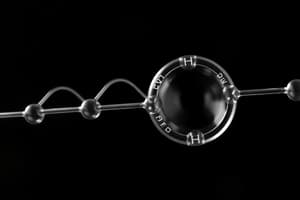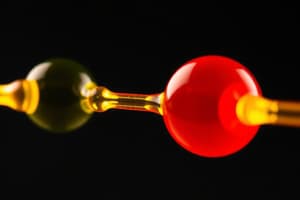Podcast
Questions and Answers
What does the term Km represent in Michaelis-Menten kinetics?
What does the term Km represent in Michaelis-Menten kinetics?
- The concentration of substrate that allows the enzyme to achieve maximum velocity
- The substrate concentration that permits the enzyme to achieve half of Vmax (correct)
- The rate of the enzyme reaction at saturating substrate concentrations
- The maximum possible production rate of the enzyme
Which plot is used to visualize the relationship between the substrate concentration and the reaction rate in Michaelis-Menten kinetics?
Which plot is used to visualize the relationship between the substrate concentration and the reaction rate in Michaelis-Menten kinetics?
- Lineweaver-Burk plot
- Arrhenius plot
- Michaelis-Menten plot (correct)
- Bowditch plot
What effect do enzyme inhibitors have on enzymatic reactions?
What effect do enzyme inhibitors have on enzymatic reactions?
- They increase the maximum velocity of the enzyme
- They accelerate the reaction rate significantly
- They prevent substrate binding or catalysis (correct)
- They modify the structural integrity of the enzyme permanently
In the context of enzyme kinetics, what does the term Vmax refer to?
In the context of enzyme kinetics, what does the term Vmax refer to?
Which of the following describes a characteristic of reversible enzyme inhibition?
Which of the following describes a characteristic of reversible enzyme inhibition?
What happens to Km in competitive inhibition?
What happens to Km in competitive inhibition?
Which type of inhibition results in both decreased Km and Vmax?
Which type of inhibition results in both decreased Km and Vmax?
In mixed inhibition, when KI < K'I, what is the effect on Km?
In mixed inhibition, when KI < K'I, what is the effect on Km?
Which type of inhibition allows the Vmax to remain unaffected?
Which type of inhibition allows the Vmax to remain unaffected?
What characterizes noncompetitive inhibition?
What characterizes noncompetitive inhibition?
What is a characteristic feature of uncompetitive inhibitors?
What is a characteristic feature of uncompetitive inhibitors?
When comparing mixed inhibition and noncompetitive inhibition, what is a key difference?
When comparing mixed inhibition and noncompetitive inhibition, what is a key difference?
How is the equilibrium constant KI defined in the context of inhibition?
How is the equilibrium constant KI defined in the context of inhibition?
Flashcards are hidden until you start studying
Study Notes
Enzyme Kinetics
- Enzyme kinetics is the study of the rates of enzymatic reactions.
- Michaelis-Menten (MM) kinetics is a model that describes the behavior of enzymes based on substrate concentration.
- MM equation: v = (Vmax * [S]) / (Km + [S]) where:
- v is the reaction rate
- Vmax is the maximum possible reaction rate
- [S] is the substrate concentration
- Km is the Michaelis constant, which is the substrate concentration at which the reaction rate is half of Vmax.
- The Michaelis-Menten plot shows the relationship between reaction rate and substrate concentration.
- The Lineweaver-Burk plot is the double reciprocal plot of the Michaelis-Menten equation, which allows for easier determination of Km and Vmax.
Enzyme Inhibition
- Enzyme inhibitors are compounds that reduce the rate of an enzymatic reaction.
- Reversible inhibition: binds to the enzyme through non-covalent interactions (can be reversed).
- Irreversible inhibition: binds to the enzyme through covalent interactions (can't be reversed)
- Types of reversible inhibition:
- Competitive inhibition: Inhibitor competes with substrate for the active site of the enzyme.
- Uncompetitive inhibition: Inhibitor binds to the enzyme-substrate complex (ES), not the free enzyme (E).
- Mixed inhibition: Inhibitor binds to both the free enzyme (E) and the enzyme-substrate complex (ES).
- Noncompetitive inhibition: Inhibitor binds with the same affinity to both the free enzyme (E) and the enzyme-substrate complex (ES).
Competitive Inhibition
- Mechanism: The inhibitor resembles the substrate and binds to the active site, preventing substrate binding.
- Lineweaver-Burk plot impact:
- Km increases (because more substrate is needed to reach half Vmax)
- Vmax remains unchanged (because the inhibitor doesn't affect the maximum reaction rate).
Uncompetitive Inhibition
- Mechanism: The inhibitor binds to a site distinct from the active site, only when the substrate is already bound to the enzyme.
- Lineweaver-Burk plot impact:
- Km decreases (because the inhibitor stabilizes the ES complex)
- Vmax decreases (because the inhibitor decreases the number of active enzyme-substrate complexes).
Mixed Inhibition
- Mechanism: The inhibitor binds to a site distinct from the active site, and can bind to both free enzyme (E) and the enzyme-substrate complex (ES).
- Lineweaver-Burk plot impact:
- If KI < K’I (inhibitor binds more strongly to free enzyme E), Km increases.
- If KI > K’I (inhibitor binds more strongly to the ES complex), Km decreases.
- Vmax decreases (because the inhibitor reduces the number of functional enzyme molecules).
Noncompetitive Inhibition
- Mechanism: The inhibitor binds to a site distinct from the active site, and binds equally well to both the free enzyme (E) and enzyme-substrate complex (ES).
- Lineweaver-Burk plot impact:
- Km remains unchanged (because the inhibitor doesn't affect the substrate binding).
- Vmax decreases (because the inhibitor reduces the number of active enzyme molecules).
Studying That Suits You
Use AI to generate personalized quizzes and flashcards to suit your learning preferences.



